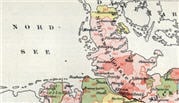Source Information
About Mönchengladbach, Germany, Births, 1798-1903
About this collection
This collection contains birth records from Mönchengladbach covering the years 1798 up to and including 1903. Mönchengladbach is an independent city situated on the left (west) bank of the Rhine in the Düsseldorf district of the German state of North Rhine-Westphalia. Previous names and spellings of the area include München-Gladbach, M. Gladbach, and Mönchen Gladbach. The city is named for the now dry springs that fed the River Gladbach. In addition to Mönchengladbach, another 12 communities are included in the collection. These communities were previously autonomous but have over the years become suburbs of the city. Accordingly, the date ranges for individual communities may vary. During the time period of this collection, Mönchengladbach, called Maire Gladbach, belonged to the French Département de la Roar until 1814 and thereafter to Prussia.
Beginning on May 1, 1798, birth, marriage and death records in left-bank areas, including the city of Mönchengladbach, followed the model of the French civil registry. Throughout the Prussian provinces, civil registration was taken over and performed by local registry offices beginning on October 1, 1874.
The collected records are arranged chronologically and usually in bound yearbook form which are collectively referred to as "civil registers." Occasionally, alphabetical directories of names were also created. While churches continued to keep traditional records, the State also mandated that the personal or marital status of the entire population be recorded.
What you can find in the records
Civil registrars initially recorded births in French and without using preprinted forms. After 1814, the forms were often preprinted and filled out in German. In each record the date of a birth usually differs from the date it was registered. Depending on the individual form or on the formulations used by the registrar, you may find:
- Sequential or Certificate Number
- Registration Date
- Informant: Given Names, Last Name, Age, Occupation, Residence
- Mother: Given Names, Last Name, Maiden Name, Age, Residence
- Child: Birth Date, Time of Birth, Sex, Given Names
- Signatures
More about using this collection
In early years, birth registers have multiple entries per page which are recorded consecutively. Later, each record comprises one page. The “Informant” was usually a midwife or a relative of the child.
Civil Registry records may have had additional events from the life of the person recorded later on in the margins. These notes, sometimes referred to as "narration," can contain very useful information but they have not been indexed. As a result, information from the notes will not found via the search form.
The French Republican Calendar was used as the dating system in the registers (until December 31, 1805).
Under "Browse this collection,” select the Civil Registration Office and Year Range of the register desired.
 Need help with the German language? Find resources in our German Research Center.
Need help with the German language? Find resources in our German Research Center.